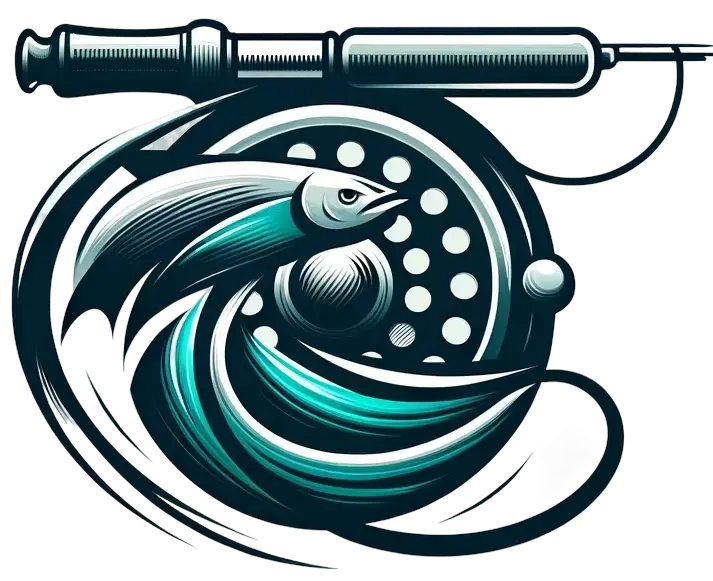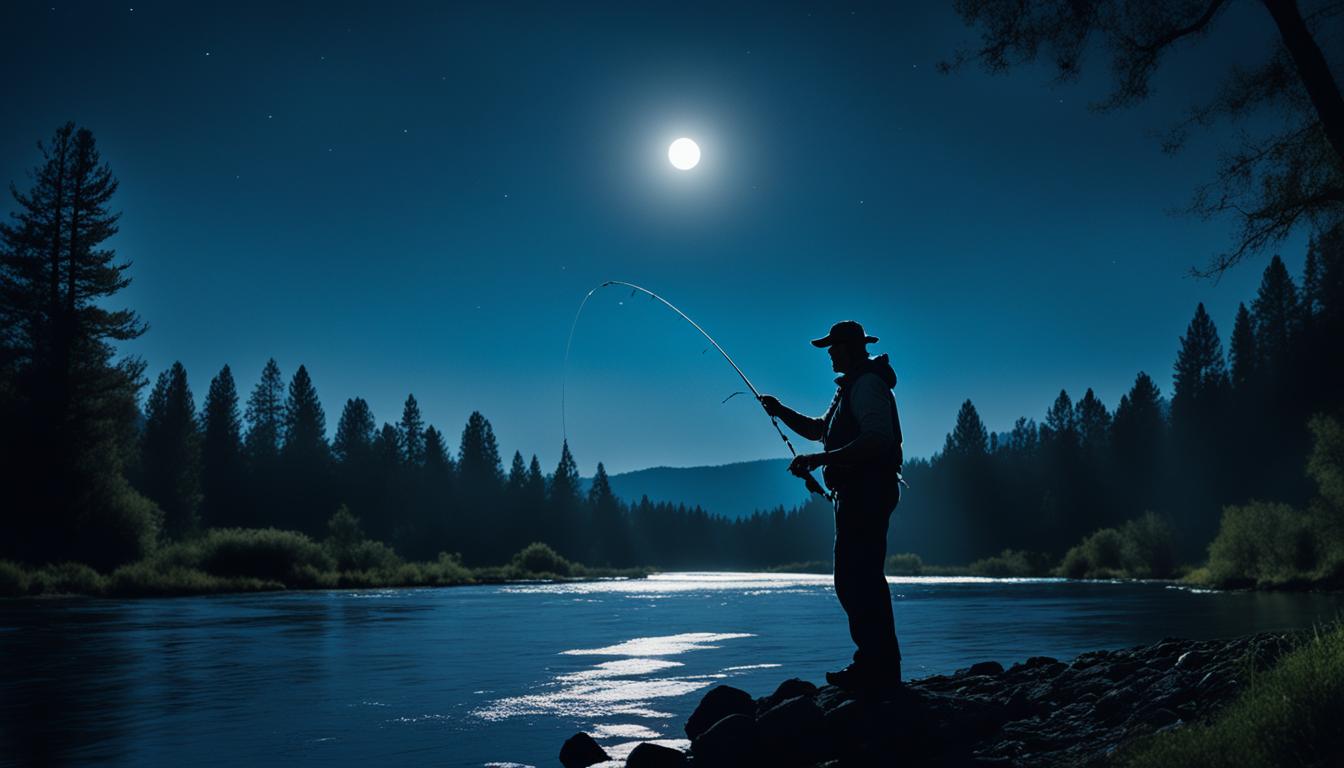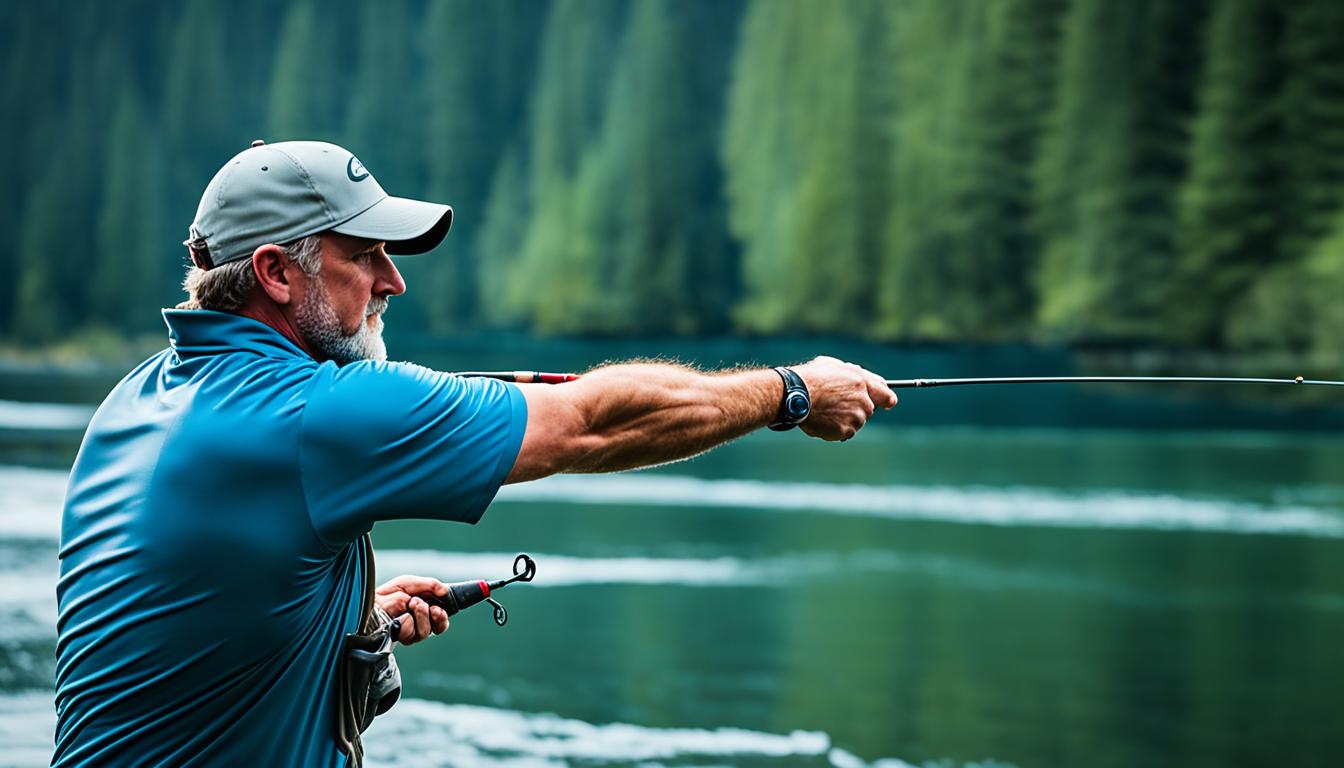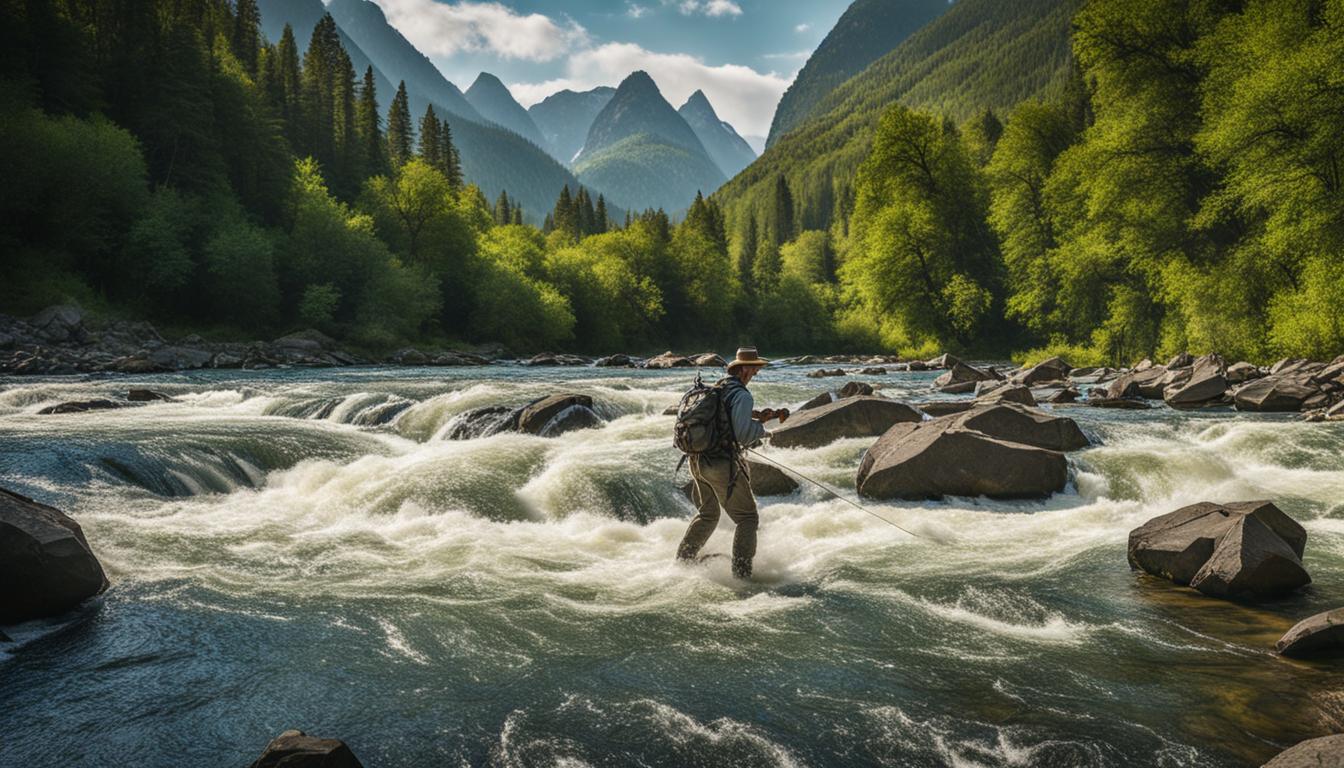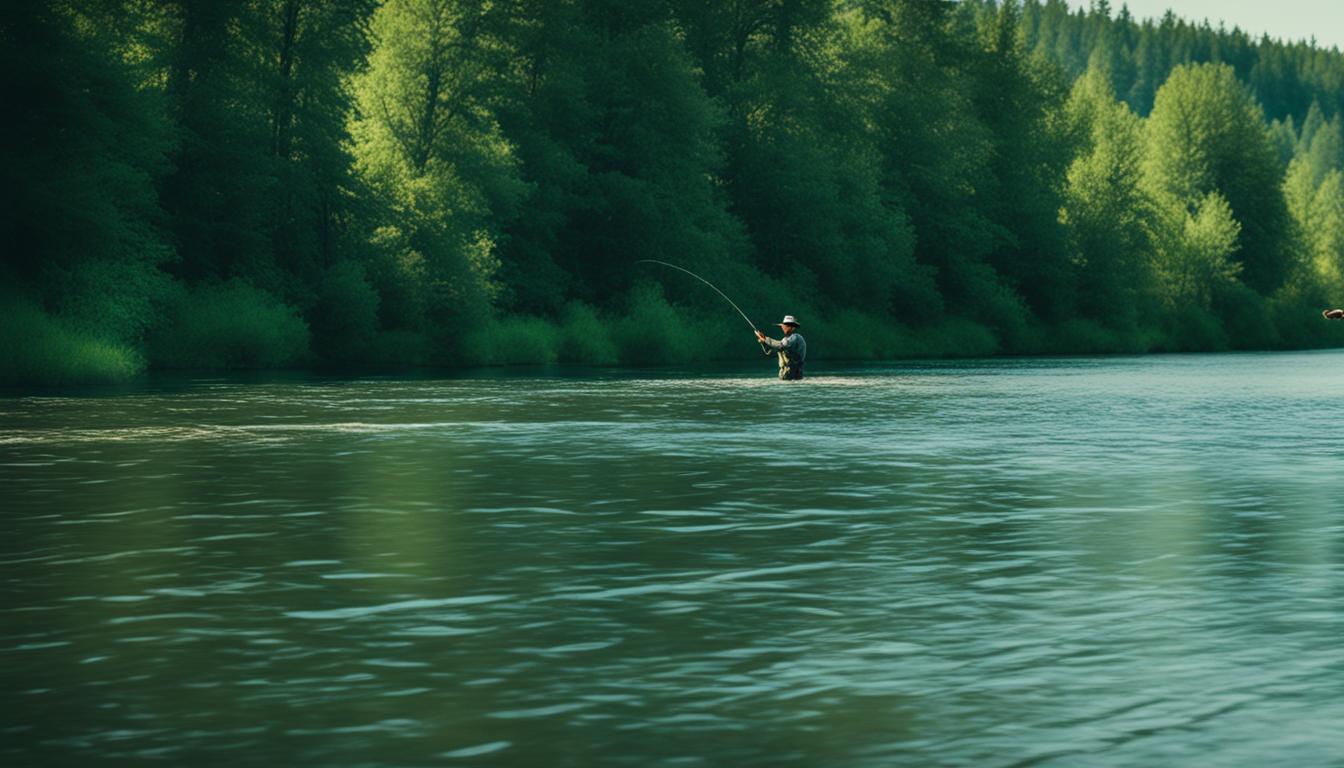Night fly fishing can be an exhilarating pursuit for anglers seeking a unique challenge and the opportunity to catch fish in low-light conditions. With the right strategies and techniques, you can increase your chances of success and have a memorable fishing experience. In this article, we will share valuable tips and advice from experienced anglers and guides to help you master night fly fishing.
Key Takeaways:
- Implement effective night fly fishing strategies to increase your chances of success.
- Understand the advantages of night fly fishing, including the increased activity of big fish and less fishing pressure.
- Select the appropriate equipment for night fly fishing, including rods, reels, lines, and safety gear.
- Choose the right fly patterns that mimic the prey commonly active at night.
- Master techniques and strategies tailored to fishing in low-light conditions, including understanding fish behavior and adjusting your casting and retrieve.
The Advantages of Night Fly Fishing
Fishing at night offers several advantages for anglers. During the nighttime hours, big fish are more active and can be found feeding aggressively. Additionally, there is less fishing pressure and competition from other anglers. To take advantage of these benefits, anglers need to develop specific techniques and strategies tailored to fishing in low-light conditions.
“Nighttime fishing brings a new level of excitement to the sport. It’s when the biggest fish come out to play. Just you, the moonlit water, and the thrill of the chase. It’s about fine-tuning your skills and employing the best night fly fishing techniques to outwit these nocturnal predators.”
Exploiting Darkness to Your Advantage
- Fishing in low-light conditions allows you to capitalize on the natural habits of big fish that become more active and aggressive during the night.
- Less fishing pressure and competition from other anglers means more opportunities for you to target and catch trophy-sized fish.
- Low-light conditions provide increased stealth, making it easier to approach fish without spooking them.
By understanding the advantages of night fly fishing, you can unlock its full potential and increase your chances of success on the water.
Next, we’ll explore the importance of selecting the right equipment for night fly fishing to further enhance your chances of landing that trophy catch.
Selecting the Right Equipment for Night Fly Fishing
When fly fishing at night, having the right equipment is crucial to maximize your chances of success. The right gear can make all the difference in enjoying a comfortable and safe nighttime fishing experience. Here are our night fly fishing gear recommendations:
Fly Rod
A well-balanced fly rod is essential for accurate casts and control while fishing in low-light conditions. Opt for a medium to fast action rod with a length between 8 to 10 feet, depending on the size of the water you’ll be fishing. This length provides enough reach for precise presentations.
Reel
Choose a reel that complements your fly rod and has a smooth drag system. It should be durable and capable of handling larger fish that are more active during the nighttime. Ensure that the reel has sufficient backing capacity to accommodate the long runs of big fish.
Fly Line
For night fly fishing, a weight-forward floating line is a versatile choice. The weight-forward design helps with casting accuracy and distance, while the floating feature ensures better visibility and control of your fly. Consider choosing a line color that contrasts with the water and the surrounding darkness.
Leader
A 9 to 12-foot fluorocarbon leader with a tippet of 2x to 4x strength works well for night fly fishing. Fluorocarbon is less visible underwater, which increases your chances of fooling wary nocturnal fish. A slightly longer leader helps with a more delicate presentation and reduces the risk of spooking fish.
Headlamp
A reliable headlamp is essential to illuminate your surroundings, tie knots, and handle equipment during nighttime fishing. Look for a headlamp with adjustable brightness levels and a red light mode to preserve night vision.
Waders and Warm Clothing
Being comfortable and protected from the elements is crucial for enjoying a successful night fly fishing trip. Invest in good-quality breathable waders to keep you dry and warm throughout the night. Layer your clothing appropriately to stay comfortable in changing temperatures.
Remember to choose gear that fits your specific needs and preferences. The equipment mentioned above is a starting point for night fly fishing, but feel free to explore other options based on your fishing location and target species.
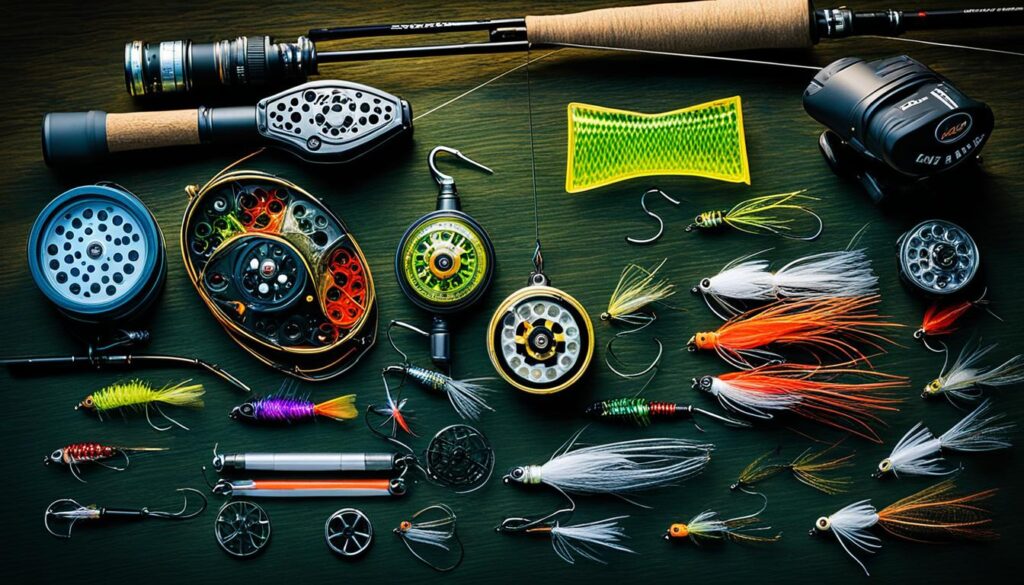
Effective Fly Patterns for Night Fly Fishing
When it comes to night fly fishing, selecting the right fly patterns is essential for enticing trout and increasing your chances of success. While daytime patterns may work to some extent, there are specific fly patterns that have proven to be highly effective in low-light conditions. Let’s explore some successful strategies for fly fishing after dark.
Mousing: The Secret Weapon
One of the most exciting and productive techniques for night fly fishing is mousing. Mousing involves imitating a mouse swimming on the water’s surface, which can be irresistible to hungry trout. Using mouse fly patterns with foam or deer hair can create a lifelike silhouette that triggers aggressive strikes. When fishing with mouse patterns, make sure to use a slow, jerky retrieve to imitate the natural movement of a mouse.
Streamers: A Reliable Choice
In addition to mousing, streamer patterns are another go-to choice for night fly fishing. Streamers are large, imitation baitfish patterns that can provoke strikes from predatory trout, especially under the cover of darkness. Choose streamers in dark colors such as black, olive, or brown to mimic the prey fish commonly active at night. Experiment with different sizes and retrieves to find the combination that works best for your local waters.
Nymphs: Effective Subsurface Patterns
While fishing on the surface can be exciting, it’s important not to overlook subsurface patterns when fly fishing after dark. Nymphs that mimic insects that are active at night, such as caddis or stonefly patterns, can attract feeding trout that are holding deeper in the water column. Use nymph patterns in darker colors, like brown or black, and fish them near the bottom using a slow retrieve to imitate natural movement.
Remember: It’s crucial to experiment with different fly patterns and sizes to determine what works best in your local waters. Pay attention to the behavior and feeding patterns of the fish, as well as any specific insects or prey fish that are active at night. By fine-tuning your fly selection, you can increase your chances of success and land more fish under the cover of darkness.
Techniques and Strategies for Night Fly Fishing
When it comes to mastering night fishing with flies and catching more fish at night, specific techniques and strategies can greatly enhance your success on the water. Understanding fish behavior and feeding patterns at night is crucial for effectively targeting and enticing them.
One important aspect to consider is your casting technique. In low-light conditions, it’s essential to cast with precision and accuracy. Take the time to practice your casting skills during the day so that you’re confident and comfortable when it’s dark. Additionally, using a fly line with a bright-colored section or a luminescent leader can help you track your line and make adjustments during the retrieve.
It’s also crucial to adjust your retrieve to imitate natural movement. Fish rely heavily on their senses, especially their lateral line, to detect movement and locate prey. By varying your retrieve speed, pausing intermittently, and adding subtle twitches or movements, you can create a more lifelike presentation that entices fish to strike.
Stealth and Noise Reduction
When fishing in low-light conditions, it’s important to be mindful of your presence and minimize noise disturbance. Fish are particularly sensitive to vibrations and can be easily spooked. To increase your chances of success, practice stealthy approaches and avoid unnecessary noise.
“To master night fishing with flies, you need to become one with the water. Move slowly and quietly, avoiding any sudden movements that can disturb the fish. Remember, patience and finesse are the keys to success in the darkness.”
Additionally, using a headlamp with a red or green light instead of a bright white light can help preserve your night vision while still providing enough illumination to tie knots and handle your gear.
Proper Fly Selection
Your choice of flies can significantly impact your success when night fishing. While mousing is a popular technique for targeting larger trout, it’s important to match the prevalent prey fish or insects in your local waters. Consider using streamer patterns that imitate baitfish or nymph patterns that resemble insect larvae or pupae that are active at night.
Experimentation is key to determining the most effective flies for your specific fishing location and conditions. Keep a variety of patterns and sizes in your fly box and be prepared to switch tactics if your initial choices aren’t producing results.
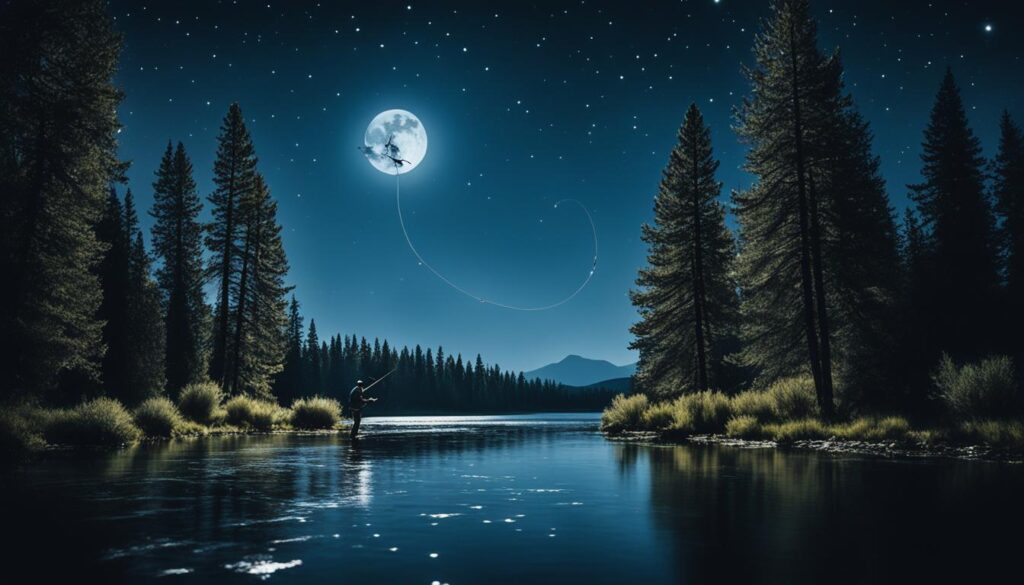
Recommended Flies for Night Fishing
| Fly Pattern | Description |
|---|---|
| Mouse Fly | Designed to imitate a swimming mouse, an irresistible meal for large trout. |
| Streamer | Imitates baitfish and provokes aggressive strikes from predatory fish. |
| Nymph | Mimics nighttime insect larvae or pupae, a common food source for trout. |
Remember, the key to successful night fly fishing is to adapt your techniques, adjust your retrieve, and choose the right flies for the conditions. By implementing these strategies and focusing on stealth and noise reduction, you’ll greatly increase your chances of mastering night fishing with flies and catching more fish at night.
Understanding Feeding Times for Night Fly Fishing
Fish have specific feeding times during the night when they are most active and aggressive. Understanding these feeding times and targeting them can greatly increase your chances of landing a trophy trout. Factors such as moon phases, cloud cover, and water temperature can influence fish feeding behavior at night, and anglers should plan their fishing trips accordingly.
One of the key nighttime fly fishing tips is to pay attention to moon phases. Fish tend to be more active during full moons, as the increased light allows them to see and hunt more effectively. On the other hand, during new moons or darker nights, fish may be less active and more difficult to catch. Keeping track of lunar cycles can help you identify the best nights for productive night fly fishing.
Cloud cover is another important factor to consider when planning your night fly fishing trips. On cloudy nights, the lack of moonlight can make fish feel more secure and confident, leading them to venture out and feed more freely. Cloud cover also provides additional cover for anglers, making it easier to approach fish stealthily. However, on clear nights, fish may be more cautious and choose to stay hidden or in deeper water. Adjusting your strategies according to the cloud cover can significantly enhance your night fly fishing success.
Water temperature plays a crucial role in fish feeding behavior, regardless of the time of day. During the warmer months, fish tend to be more active and aggressive during the cooler nighttime hours, seeking prey and cooler water temperatures. As temperatures drop during the colder months, fish may feed less frequently or become more selective in their choice of food. Monitoring water temperatures and adjusting your tactics accordingly can help you effectively target feeding times and improve your night fly fishing results.
“Understanding the feeding times for night fly fishing is essential for maximizing your chances of success,” says experienced angler, John Smith. “By paying attention to moon phases, cloud cover, and water temperature, you can plan your trips accordingly and increase your chances of landing trophy trout.”
By understanding the feeding times for night fly fishing and taking advantage of optimal conditions, anglers can increase their chances of success on the water. Stay tuned for our next section, where we will discuss safety tips for night fly fishing to ensure a safe and enjoyable fishing experience at night.
Safety Tips for Night Fly Fishing
Fishing at night can be an exhilarating experience, but it also presents unique challenges and potential safety risks. To ensure your safety and the safety of others, it’s important to take precautions and be prepared. Here are some essential tips for fishing at night:
Inform Someone of Your Fishing Plans
Before heading out for a night fly fishing adventure, let someone know where you’ll be fishing and when you expect to return. This way, if anything goes wrong, help can be alerted and sent your way.
Wear Appropriate Safety Gear
When fishing at night, visibility is reduced, making it crucial to wear reflective clothing or accessories. This helps other anglers and boaters spot you in low-light conditions. It’s also important to wear a life jacket or personal flotation device, especially if you’ll be wading in deeper waters.
Be Aware of Your Surroundings
In the darkness, it’s essential to pay close attention to your surroundings. Be mindful of potential hazards such as rocks, logs, and obstacles that may be harder to see at night. Take slow and deliberate steps when wading, ensuring you maintain your balance and avoid accidental slips or falls.
Fish with a Partner or Group
Fishing with a partner or a group can enhance safety while night fly fishing. Having someone with you provides an extra set of eyes and assistance in case of an emergency. It also adds to the enjoyment and camaraderie of the experience.
Bring Adequate Lighting
Carry a reliable and waterproof headlamp or flashlight to illuminate your path and tie knots. Having a light source is essential for navigating the dark and ensuring you can see where you’re stepping.
Remember, fishing at night requires extra caution and preparation compared to daytime fishing. By following these safety tips, you can enjoy the thrill of night fly fishing while minimizing potential risks. Stay safe and tight lines!
Conclusion
Night fly fishing offers a unique and thrilling experience for anglers who are willing to embrace the challenges of fishing in low-light conditions. By implementing effective strategies, selecting the right equipment, and understanding fish behavior, you can significantly increase your chances of success and catch more fish at night.
To improve your nighttime fly fishing skills, remember to consider the advantages of fishing after dark. Big fish are more active at night, and there is often less fishing pressure, providing you with an excellent opportunity to land a trophy trout. Utilizing the best night fly fishing techniques, such as mousing and using fly patterns that mimic nighttime prey, can greatly enhance your chances of enticing strikes.
When embarking on a night fly fishing adventure, prioritize safety. Inform someone of your fishing plans and wear appropriate safety gear. Fishing with a partner or group can offer added safety and support if needed. Remember to be aware of your surroundings and take precautions to ensure a successful and safe nighttime fishing experience.
So, gear up, plan your fishing trips around fish feeding times, and venture out into the darkness to experience the thrill of night fly fishing. With the right strategies and knowledge, you’ll be well on your way to catching more fish and creating unforgettable memories under the starlit sky.
FAQ
What are some advantages of night fly fishing?
Fishing at night allows anglers to target more active and aggressive fish, with less competition from other anglers.
What equipment do I need for night fly fishing?
Some essential equipment includes a suitable fly rod, reel, fly line, leader, headlamp, waders, and warm clothing for comfort and safety.
What are the recommended fly patterns for night fly fishing?
Mousing with mouse fly patterns, as well as using streamers and nymphs that imitate prey fish or insects, have shown to be effective for night fly fishing.
What techniques and strategies should I use for night fly fishing?
Understanding fish behavior, using appropriate casting techniques, adjusting your retrieve, and prioritizing noise reduction and stealth are important techniques for success.
How can I determine the feeding times for night fly fishing?
Factors such as moon phases, cloud cover, and water temperature can influence fish feeding behavior at night, and anglers should plan their fishing trips accordingly.
What safety precautions should I take for night fly fishing?
Informing someone of your fishing plans, wearing appropriate safety gear, being aware of your surroundings, and fishing with a partner or group can enhance safety during nighttime fishing.
